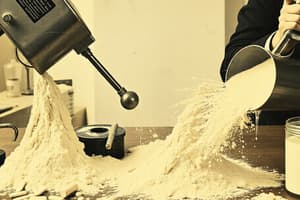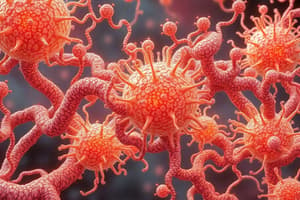Podcast
Questions and Answers
Free Energy (G) has two components, Enthalpy (H) and Entropy (S)?
Free Energy (G) has two components, Enthalpy (H) and Entropy (S)?
True (A)
The Law of Conservation of Energy states that energy can be created but not destroyed?
The Law of Conservation of Energy states that energy can be created but not destroyed?
False (B)
Changes in entropy deal with changes in chemical bonding or non-covalent interactions?
Changes in entropy deal with changes in chemical bonding or non-covalent interactions?
False (B)
Energy comes in two main types: Kinetic energy and Mechanical energy?
Energy comes in two main types: Kinetic energy and Mechanical energy?
Enthalpy has a larger contribution to free energy at high temperatures?
Enthalpy has a larger contribution to free energy at high temperatures?
Hess’ Law deals with changes in equilibrium and Gibbs Free Energy?
Hess’ Law deals with changes in equilibrium and Gibbs Free Energy?
Energy can be created and destroyed according to the law of thermodynamics.
Energy can be created and destroyed according to the law of thermodynamics.
The surroundings in a thermodynamic system refer to the vessel of interest where reactions take place.
The surroundings in a thermodynamic system refer to the vessel of interest where reactions take place.
An open system can exchange both energy and matter with its surroundings.
An open system can exchange both energy and matter with its surroundings.
Adiabatic barriers allow for efficient energy transfer between the system and surroundings.
Adiabatic barriers allow for efficient energy transfer between the system and surroundings.
If A is in thermal equilibrium with B, and B is in thermal equilibrium with C, then A will also be in thermal equilibrium with C according to the Zeroth Law of Thermodynamics.
If A is in thermal equilibrium with B, and B is in thermal equilibrium with C, then A will also be in thermal equilibrium with C according to the Zeroth Law of Thermodynamics.
Work is required to push air from the lungs against atmospheric pressure.
Work is required to push air from the lungs against atmospheric pressure.
A system does the most work possible when the opposing pressure is greater than the internal pressure.
A system does the most work possible when the opposing pressure is greater than the internal pressure.
The heat capacity of a substance can be used to obtain the quantity of transferred heat via q = CΔT.
The heat capacity of a substance can be used to obtain the quantity of transferred heat via q = CΔT.
For reversible isothermal expansion of a perfect gas, the internal energy ΔU is equal to zero.
For reversible isothermal expansion of a perfect gas, the internal energy ΔU is equal to zero.
The internal energy of a system refers to the total energy (kinetic + potential) of all the atoms, molecules, and ions constituting the system.
The internal energy of a system refers to the total energy (kinetic + potential) of all the atoms, molecules, and ions constituting the system.
The first law of thermodynamics states that isolated systems can do work upon or heat their surroundings.
The first law of thermodynamics states that isolated systems can do work upon or heat their surroundings.
For any system that does work, new sources of energy must be supplied at regular intervals.
For any system that does work, new sources of energy must be supplied at regular intervals.
Enthalpy equals the change in internal energy plus the product of pressure and change in volume.
Enthalpy equals the change in internal energy plus the product of pressure and change in volume.
For an open system with external pressure pex, the change in enthalpy equals the heat transferred at constant pressure.
For an open system with external pressure pex, the change in enthalpy equals the heat transferred at constant pressure.
An exothermic process involves energy leaving the system as heat and has a positive change in enthalpy.
An exothermic process involves energy leaving the system as heat and has a positive change in enthalpy.
The heat capacity at constant pressure, Cp, is equal to the change in enthalpy divided by the change in temperature.
The heat capacity at constant pressure, Cp, is equal to the change in enthalpy divided by the change in temperature.
The standard molar enthalpy of a substance is denoted by Hmo and represents its enthalpy at 25°C and exactly 1 bar pressure.
The standard molar enthalpy of a substance is denoted by Hmo and represents its enthalpy at 25°C and exactly 1 bar pressure.
The vaporization enthalpy of water is responsible for the high humidity of our climate and the presence of oceans.
The vaporization enthalpy of water is responsible for the high humidity of our climate and the presence of oceans.
Sublimation is the direct conversion of a solid to a liquid.
Sublimation is the direct conversion of a solid to a liquid.
Differential Scanning Calorimetry measures the difference in heat transferred to or from a sample in comparison to a reference material.
Differential Scanning Calorimetry measures the difference in heat transferred to or from a sample in comparison to a reference material.
The overall enthalpy change of a process is equal to the sum of the sublimation and vaporization enthalpies.
The overall enthalpy change of a process is equal to the sum of the sublimation and vaporization enthalpies.
Breaking bonds (dissociation) are always exothermic processes.
Breaking bonds (dissociation) are always exothermic processes.
Entropy is the measure of how concentrated energy and matter is.
Entropy is the measure of how concentrated energy and matter is.
The entropy of an isolated system tends to decrease.
The entropy of an isolated system tends to decrease.
The change in entropy of a substance is equal to the heat transferred reversibly to it divided by the temperature at which the transfer takes place.
The change in entropy of a substance is equal to the heat transferred reversibly to it divided by the temperature at which the transfer takes place.
Entropy is not a state function.
Entropy is not a state function.
When increasing the number of energy packets over 80 atoms, the probability of the hot bar getting hotter increases.
When increasing the number of energy packets over 80 atoms, the probability of the hot bar getting hotter increases.
The resulting change in entropy when transferring 100 kJ of heat to a large body of water at 0 °C is +366 J K-1.
The resulting change in entropy when transferring 100 kJ of heat to a large body of water at 0 °C is +366 J K-1.
Melting or boiling results in a decrease in entropy.
Melting or boiling results in a decrease in entropy.
The entropy of vaporization of water at 25 °C is -118 J K-1 mol-1.
The entropy of vaporization of water at 25 °C is -118 J K-1 mol-1.
Humans, even at rest, do not constantly expend energy.
Humans, even at rest, do not constantly expend energy.
At absolute zero, the absolute entropies of all perfectly crystalline substances are zero.
At absolute zero, the absolute entropies of all perfectly crystalline substances are zero.
Standard molar entropies can be obtained by following the changes in heat capacity of a given substance with temperature.
Standard molar entropies can be obtained by following the changes in heat capacity of a given substance with temperature.
Entropy can be negative for a substance at a certain temperature.
Entropy can be negative for a substance at a certain temperature.
Hydrogen peroxide is formed in the body due to reactions involving oxygen.
Hydrogen peroxide is formed in the body due to reactions involving oxygen.
The enthalpy change for the reaction 2H2O2(l) ➞ 2H2O(l) + O2(g) is -172 kJ.
The enthalpy change for the reaction 2H2O2(l) ➞ 2H2O(l) + O2(g) is -172 kJ.
Standard enthalpy of combustion for CH4(g) is -890 kJ mol-1.
Standard enthalpy of combustion for CH4(g) is -890 kJ mol-1.
Fats are used for energy storage in mammals and to provide insulation.
Fats are used for energy storage in mammals and to provide insulation.
Proteins are usually used to create new proteins instead of being employed as a fuel source.
Proteins are usually used to create new proteins instead of being employed as a fuel source.
The standard enthalpy of a reaction is the sum of the standard enthalpies of the reactions into which the overall reaction may be divided.
The standard enthalpy of a reaction is the sum of the standard enthalpies of the reactions into which the overall reaction may be divided.
During vigorous exercise, muscle cells become deprived of oxygen, leading to the production of lactic acid (LA).
During vigorous exercise, muscle cells become deprived of oxygen, leading to the production of lactic acid (LA).
Isothermal expansion of a perfect gas into a vacuum has no overall change in energy.
Isothermal expansion of a perfect gas into a vacuum has no overall change in energy.
Gas molecules move randomly, and the probability that they will move into one corner of a container is significant.
Gas molecules move randomly, and the probability that they will move into one corner of a container is significant.
Spontaneous processes necessarily move in the direction of lower energy.
Spontaneous processes necessarily move in the direction of lower energy.
Gases expand to fill empty spaces, which is a non-spontaneous process.
Gases expand to fill empty spaces, which is a non-spontaneous process.
In a cooling process, the energy lost by the system is destroyed and cannot be transferred to the surroundings.
In a cooling process, the energy lost by the system is destroyed and cannot be transferred to the surroundings.
The standard reaction entropy, ΔrS∅, is the difference in molar entropy between the products and reactants of a reaction in their standard states?
The standard reaction entropy, ΔrS∅, is the difference in molar entropy between the products and reactants of a reaction in their standard states?
The standard reaction entropy of an enzyme catalyzed reaction at 25 °C is +96.3 J K-1 mol-1?
The standard reaction entropy of an enzyme catalyzed reaction at 25 °C is +96.3 J K-1 mol-1?
Processes occur spontaneously if the overall entropy of the universe is decreased?
Processes occur spontaneously if the overall entropy of the universe is decreased?
According to the 2nd Law of Thermodynamics, the entropy of an isolated system tends to decrease?
According to the 2nd Law of Thermodynamics, the entropy of an isolated system tends to decrease?
The Gibbs energy and Entropy have the same signs?
The Gibbs energy and Entropy have the same signs?
Josiah Willard Gibbs was the first person to receive a PhD in Engineering from Yale?
Josiah Willard Gibbs was the first person to receive a PhD in Engineering from Yale?
The ΔG of any process is the maximum expansion work that can be extracted from that process at constant temperature and pressure?
The ΔG of any process is the maximum expansion work that can be extracted from that process at constant temperature and pressure?
The change in Gibbs energy accompanying combustion of glucose at 25 °C is +2828 kJ mol-1?
The change in Gibbs energy accompanying combustion of glucose at 25 °C is +2828 kJ mol-1?
ATP hydrolysis drives favorable biochemical reactions?
ATP hydrolysis drives favorable biochemical reactions?
The standard reaction Gibbs energy, ΔrGo, can be calculated using tabulated values obtained by combining standard enthalpies and entropies?
The standard reaction Gibbs energy, ΔrGo, can be calculated using tabulated values obtained by combining standard enthalpies and entropies?
Which component of free energy has a higher contribution at higher temperatures?
Which component of free energy has a higher contribution at higher temperatures?
What type of energy is associated with movement?
What type of energy is associated with movement?
In the equation G = H - TS, what does 'T' represent?
In the equation G = H - TS, what does 'T' represent?
According to the text, what type of energy is possessed due to position?
According to the text, what type of energy is possessed due to position?
What does the equation ∆Gⱡ = ∆Hⱡ - T∆Sⱡ represent?
What does the equation ∆Gⱡ = ∆Hⱡ - T∆Sⱡ represent?
What deals with changes in order or disorder associated with a process?
What deals with changes in order or disorder associated with a process?
What is the standard enthalpy of combustion for CH4(g)?
What is the standard enthalpy of combustion for CH4(g)?
What type of process is the isothermal expansion of a perfect gas into a vacuum?
What type of process is the isothermal expansion of a perfect gas into a vacuum?
Which statement about spontaneous processes is true?
Which statement about spontaneous processes is true?
What is the standard enthalpy of formation of liquid water?
What is the standard enthalpy of formation of liquid water?
What drives favorable biochemical reactions?
What drives favorable biochemical reactions?
What happens during vigorous exercise when muscle cells become deprived of oxygen?
What happens during vigorous exercise when muscle cells become deprived of oxygen?
What is the enthalpy change for glycolysis?
What is the enthalpy change for glycolysis?
What is the energy input required per day for 18-20 year old males?
What is the energy input required per day for 18-20 year old males?
Which type of fuel provides 17 kJ g-1?
Which type of fuel provides 17 kJ g-1?
What do proteins do in mammals?
What do proteins do in mammals?
What happens to fats in mammals?
What happens to fats in mammals?
How does body temperature regulated?
How does body temperature regulated?
What is the standard reaction entropy, ΔrS∅, for the reaction catalyzed by carbonic anhydrase?
What is the standard reaction entropy, ΔrS∅, for the reaction catalyzed by carbonic anhydrase?
What does the change in Gibbs energy, ΔG, represent for any process?
What does the change in Gibbs energy, ΔG, represent for any process?
At pH = 7.0 and T = 37 °C, what is the standard enthalpy change, ΔrH, for ATP hydrolysis?
At pH = 7.0 and T = 37 °C, what is the standard enthalpy change, ΔrH, for ATP hydrolysis?
What is the relationship between Gibbs energy and entropy for spontaneous processes?
What is the relationship between Gibbs energy and entropy for spontaneous processes?
What is the maximum nonexpansion work that can be extracted from a process at constant temperature and pressure?
What is the maximum nonexpansion work that can be extracted from a process at constant temperature and pressure?
What is the standard reaction Gibbs energy, ΔrGo, for the reaction catalyzed by carbonic anhydrase at 25 °C?
What is the standard reaction Gibbs energy, ΔrGo, for the reaction catalyzed by carbonic anhydrase at 25 °C?
What drives unfavourable biochemical reactions by providing up to 31 kJ of energy in the form of non-expansion work?
What drives unfavourable biochemical reactions by providing up to 31 kJ of energy in the form of non-expansion work?
What is the relationship between Gibbs energy and spontaneity?
What is the relationship between Gibbs energy and spontaneity?
At what temperature are the absolute entropies of all perfectly crystalline substances zero?
At what temperature are the absolute entropies of all perfectly crystalline substances zero?
What happens to Gibbs energy and entropy for spontaneous processes?
What happens to Gibbs energy and entropy for spontaneous processes?
If a process has a change in Gibbs energy of -2828 kJ mol-1 at 25 °C, what type of work does it represent?
If a process has a change in Gibbs energy of -2828 kJ mol-1 at 25 °C, what type of work does it represent?
What is the relationship between Gibbs energy and enthalpy for any process?
What is the relationship between Gibbs energy and enthalpy for any process?
What is the measure of how dispersed energy and matter is?
What is the measure of how dispersed energy and matter is?
What is the change in entropy of a substance equal to?
What is the change in entropy of a substance equal to?
What is the probability that we end up with 9 packets in the HOT bar, and 1 packet in the COLD bar?
What is the probability that we end up with 9 packets in the HOT bar, and 1 packet in the COLD bar?
What happens to the probability of the hot bar getting hotter as we increase the number of energy packets over 80 atoms?
What happens to the probability of the hot bar getting hotter as we increase the number of energy packets over 80 atoms?
What is the standard molar entropy, Sm∅, the measure of?
What is the standard molar entropy, Sm∅, the measure of?
In which scenario does entropy change, ΔS, increase?
In which scenario does entropy change, ΔS, increase?
What does melting or boiling result in?
What does melting or boiling result in?
What does the standard molar entropy, Sm∅, measure?
What does the standard molar entropy, Sm∅, measure?
What does a person at rest constantly expend?
What does a person at rest constantly expend?
What does the Third Law of Thermodynamics state?
What does the Third Law of Thermodynamics state?
"The amount of heat passing to / from the surroundings is equal and opposite to the heat leaving / entering the system". What does this statement imply?
"The amount of heat passing to / from the surroundings is equal and opposite to the heat leaving / entering the system". What does this statement imply?
"Josiah Willard Gibbs was the first person to receive a PhD in Engineering from Yale?". Is this statement true?
"Josiah Willard Gibbs was the first person to receive a PhD in Engineering from Yale?". Is this statement true?
What is the fundamental principle of the conservation of energy?
What is the fundamental principle of the conservation of energy?
What is the system in thermodynamics?
What is the system in thermodynamics?
Which type of system can exchange energy but not matter with its surroundings?
Which type of system can exchange energy but not matter with its surroundings?
What is the sign convention for work done on a system?
What is the sign convention for work done on a system?
What is the formula for work associated with gas expansion?
What is the formula for work associated with gas expansion?
What happens when work is required to push air from the lungs against atmospheric pressure?
What happens when work is required to push air from the lungs against atmospheric pressure?
What does the first law of thermodynamics state about the internal energy of a perfect gas during isothermal expansion?
What does the first law of thermodynamics state about the internal energy of a perfect gas during isothermal expansion?
What is internal energy in thermodynamics?
What is internal energy in thermodynamics?
How can the quantity of heat transferred be obtained using heat capacity?
How can the quantity of heat transferred be obtained using heat capacity?
In thermodynamics, what does the first law state about isolated systems?
In thermodynamics, what does the first law state about isolated systems?
What is the relationship between enthalpy change (ΔH) and heat transferred (q) for an exothermic process?
What is the relationship between enthalpy change (ΔH) and heat transferred (q) for an exothermic process?
What is responsible for the low humidity of the climate and the presence of oceans, according to the text?
What is responsible for the low humidity of the climate and the presence of oceans, according to the text?
What does sublimation refer to in thermodynamics?
What does sublimation refer to in thermodynamics?
What does differential scanning calorimetry measure?
What does differential scanning calorimetry measure?
What represents the standard molar enthalpy of a substance?
What represents the standard molar enthalpy of a substance?
What is the standard reaction entropy (ΔrS∅) used to measure?
What is the standard reaction entropy (ΔrS∅) used to measure?
What is responsible for the high vaporization enthalpy of water?
What is responsible for the high vaporization enthalpy of water?
What does the standard reaction Gibbs energy ($ ext{ΔrG∅}$) represent?
What does the standard reaction Gibbs energy ($ ext{ΔrG∅}$) represent?
What does the standard molar enthalpy ($H^o_m$) represent?
What does the standard molar enthalpy ($H^o_m$) represent?
What contributes to the low humidity of our climate and presence of oceans?
What contributes to the low humidity of our climate and presence of oceans?
Which process involves energy entering the system as heat?
Which process involves energy entering the system as heat?
Flashcards are hidden until you start studying
Study Notes
Free Energy and Thermodynamics
- Free Energy (G) is comprised of Enthalpy (H) and Entropy (S), represented as G = H - TS.
- Enthalpy has a greater influence on free energy at elevated temperatures.
- Gibbs Free Energy is the maximum work obtainable from a thermodynamic process at constant temperature and pressure.
Thermodynamic Laws and Systems
- The Law of Conservation of Energy states that energy can neither be created nor destroyed, only transformed.
- Open systems can interchange energy and matter with their surroundings, while closed systems can exchange only energy.
- Adiabatic barriers facilitate efficient energy transfer between systems and surroundings.
Thermal Equilibrium and Pressure
- Zeroth Law of Thermodynamics asserts that if A is in thermal equilibrium with B, and B with C, then A is in equilibrium with C.
- Work is necessary to expel air from the lungs against atmospheric pressure.
- A system accomplishes maximum work when external pressure exceeds internal pressure.
Internal Energy and Heat Transfer
- Internal energy (ΔU) includes all kinetic and potential energy of particles within a system.
- The relationship for heat transfer is defined by q = CΔT, where C is heat capacity.
Phase Changes and Enthalpy
- Exothermic processes involve heat leaving the system, resulting in a positive change in enthalpy.
- The standard molar enthalpy (Hmo) is measured at 25°C and 1 bar pressure.
- Enthalpy changes during phase transitions (e.g., vaporization and sublimation) are significant in climate dynamics.
Entropy and Energy Distribution
- Entropy measures energy and matter distribution, indicating the degree of disorder in a system.
- The entropy of an isolated system generally tends to increase.
- A change in entropy is calculated by the heat transferred reversibly divided by the temperature.
Spontaneous Processes
- Processes occur spontaneously if they contribute to an overall increase in the entropy of the universe.
- Spontaneous processes favor lower energy states and higher disorder.
Combustion and Biochemical Reactions
- Standard enthalpy of combustion for methane (CH4) is -890 kJ mol-1.
- Ideal enthalpy change for glycolysis and lactic acid buildup during oxygen deprivation in muscles.
- ATP hydrolysis is a key process that drives many biochemical reactions by releasing energy.
Statistical Mechanics and Probability
- As the number of energy packets increases, the likelihood of energy concentration changes, affecting temperature.
- Melting or boiling transitions typically correspond with an increase in entropy.
Key Temperature Concepts
- Absolute zero absolute entropy for perfectly crystalline substances is defined as zero entropy.
- At specific conditions (pH = 7.0 and T = 37°C), standard enthalpy changes and reaction gibbs energies can be evaluated.
Fuel and Energy Utilization
- Fats serve dual roles in energy storage and insulation in mammals, while proteins are primarily utilized for biosynthesis rather than as fuels.
- Energy input for young males is significant, and different fuel types provide varying energy yields per gram.
Thermodynamic Relationships
- The standard reaction entropy (ΔrS∅) represents the change in entropy from reactants to products in standard states.
- Entropy can be a negative value under specific temperatures.
- A negative change in Gibbs energy indicates a spontaneous process and can be interpreted as non-expansion work potential.
Summary of Formulas and Concepts
- The general relationship between Gibbs energy and enthalpy for processes can be summarized as ΔG = ΔH - TΔS.
- Standard reaction Gibbs energy can be derived from enthalpy and entropy values under standard conditions.
Studying That Suits You
Use AI to generate personalized quizzes and flashcards to suit your learning preferences.





